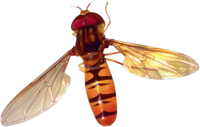The Genetics of the Dancing Bees

When I was ten years old, I picked up one of my father’s old books. By the end of page one I was hooked, and I am sure that it was one of the pivotal points of my life that lead to my subsequent careers.
The book was the Dancing Bees: An Account of the Life and Senses of Honey Bee by Karl von Frisch. I still have it: my edition is now 51 years old, and showing its age.
The book may have faded but its brilliant ideas have not. In 1973, along with Nikolaas Tinbergen and Konrad Lorenz, Von Frisch won the Nobel Prize in Physiology or Medicine.
Honey bees are an ideal group of animals for studying behavior. When they are young, adult worker bees perform a number of tasks in the hive including caring for eggs and larvae. As they age, their job description changes and they shift to foraging for nectar and pollen. However, if the hive has a shortage of foragers, some of the young nurse bees will switch jobs early and go out foraging.
This job transition, whether it is triggered by age or social or environmental cues, involves changes in thousands of genes in the honey bee brain; some genes turning on, while others turning off.
The gene switching is achieved by short strings of DNA that lie close to and modulated each gene or set of genes. The strings serve as binding sites for particular molecules called transcription factors. When the correct transcription factor finds its the binding site, the accompanying gene may be switched on. If the transcription factor breaks away from the binding site, the gene is switched off.
New research funded by the University of Illinois and the National Science Foundation was published in two papers 1. 2. in this week’s Proceedings of the National Academy of Sciences. It used a new approach to try and understand the genetic underpinnings of some of this social behavior. Scientists have recently sequenced the genome of the honey bee, so the researchers’ strategy was to scan the binding sites of transcription factors known to function in the development of fruit flies from a single cell to an adult.
It is noteworthy that two of the researchers are computer scientists, showing us how often we need their help in designing and executing a lot of cutting edge research.
A computer algorithm that they wrote scanned nearly 3,000 genes. Statistical techniques were then used to investigate whether particular transcription factors correlated with genes that were turned on or off (what we call differentially expressed) between nurse bees and foragers.
The answer was the discovery of five different transcription factors that showed a statistically significant correlation with socially regulated genes. I sometimes wonder about the ponderous humor of some scientists: the five transcription factors – known, in fruit flies, to be involved in the development of the nervous system development, olfactory learning and hormone binding – have the names Hairy, GAGA, Adf1, Cf1, Snail, and Dri.
We also have another example of Mother Nature wasting nothing. Some of the same genes involved in the development of the nervous system of fruit flies are re-used for behavioral functions in adult honey bees. There are significant differences in the ways in which the honey bee and fruit fly genes are regulated. It is those regulatory processes that help to ensure that the genes end up producing honey bee behavior and not a fruit fly brain.
These findings suggest that honey bees may well turn out to be useful in elucidating the mechanisms by which social factors regulate gene expression in humans, as well as the effect of environmental factors on the expression of genes involved in social behavior.
There is every reason to believe that some of the same genes will be used in the human brain. The gene regulators will make all the difference in determining whether a bee becomes a nurse or a forager or a human becomes a sinner or a saint: they respond to a child’s environment, cognitions, attitudes, and perhaps even their spirituality.
If you are interested in a brief entree to the interactions between positive psychology and gene expression, together with some brief comments by yours truly, you may be interested to have a look here.






